How to grow Asian pears – experts reveal their tips for cultivating this juicy delicacy
Knowing how to grow Asian pears will expand your edible horizons with exquisitely crunchy crops from generously blessed fruit trees
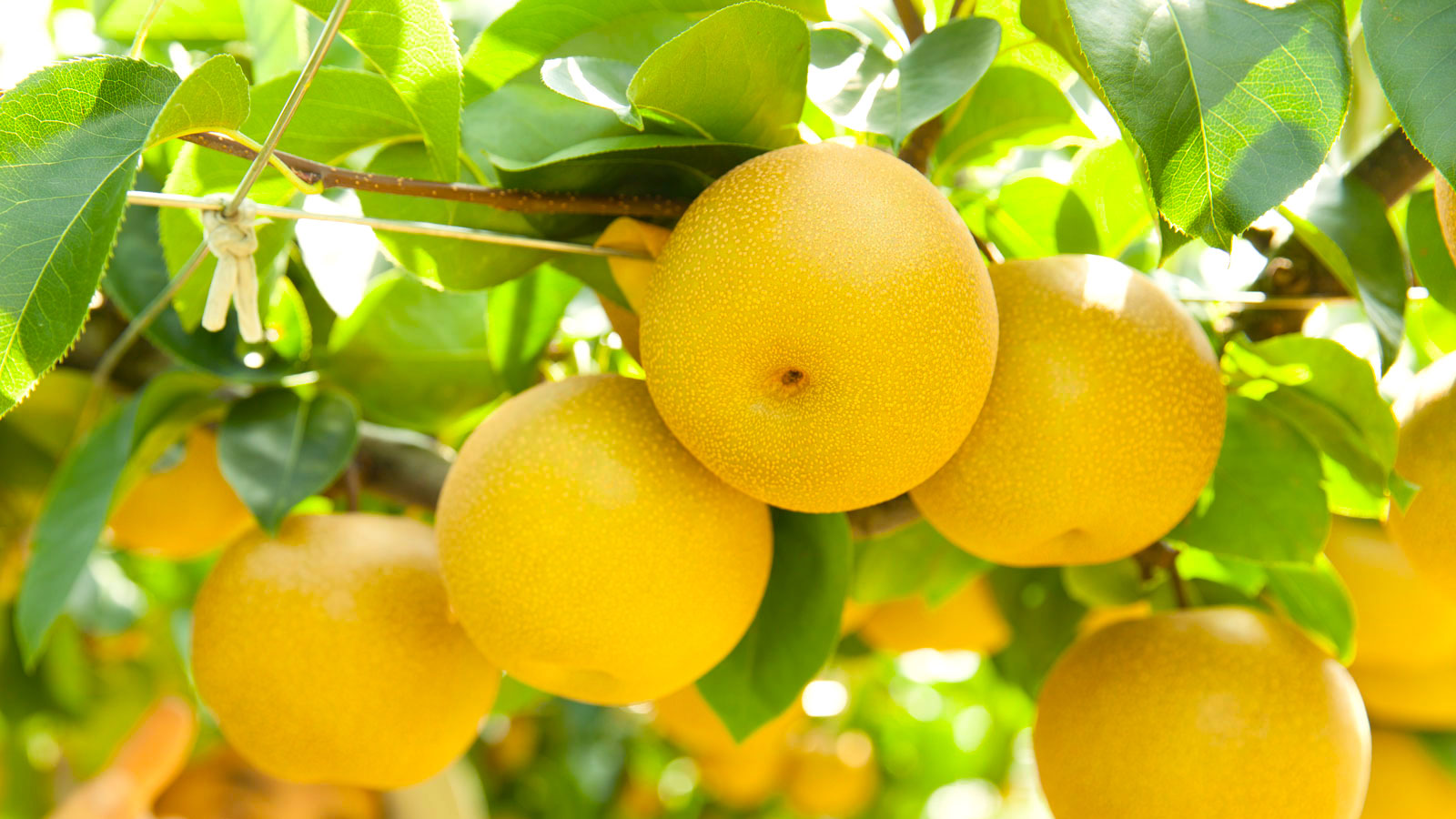

When you learn how to grow Asian pears, you’ll be forgiven for thinking you are growing an exotic hybrid of two fruits. The nashi or apple pear, as it is known, is as succulent and crunchy as an apple, with a delicate, perfumed and unmistakably ‘pear’ quality. But the affectionately named ‘papple’ is all pear – and the way it fits generously into the palm of the hand is a sign of heft and quality. Firm and crispy, mild and sweet, these pears (Pyrus pyrifolia) are amongst the most sizable, high-yielding fruit trees you can grow in your backyard or kitchen garden.
Said to be the oldest pear ever grown, nashi were enjoyed thousands of years ago as an edible treat for nobility. But while once the domain of a select few, the sand pear or zodiac pear is now catching on with more home growers. You don’t need large spaces or special soils: just sunshine, water, and proper care. Growing Asian pears gives a delicious source of vitamins, minerals, fibers and antioxidants. Packed with vitamins C and K, potassium, copper and manganese, these sublime fruits will foster strong tissues and bone health, plus an improved immune system.
As with all the best fruit trees, Asian pears are versatile in terms of planting and enjoying. Perfect as standalone tree specimens or as part of a mini orchard, they complement sweet and savory recipes. Oozing with honeyed juices when sampled fresh from the branches, the fruits also work well in exotic salads, sauces, pies, wraps, desserts, risottos, cheese dishes and cakes. So, sink your teeth into nashi and find out how rewarding it is to grow these intriguing aromatic marvels.
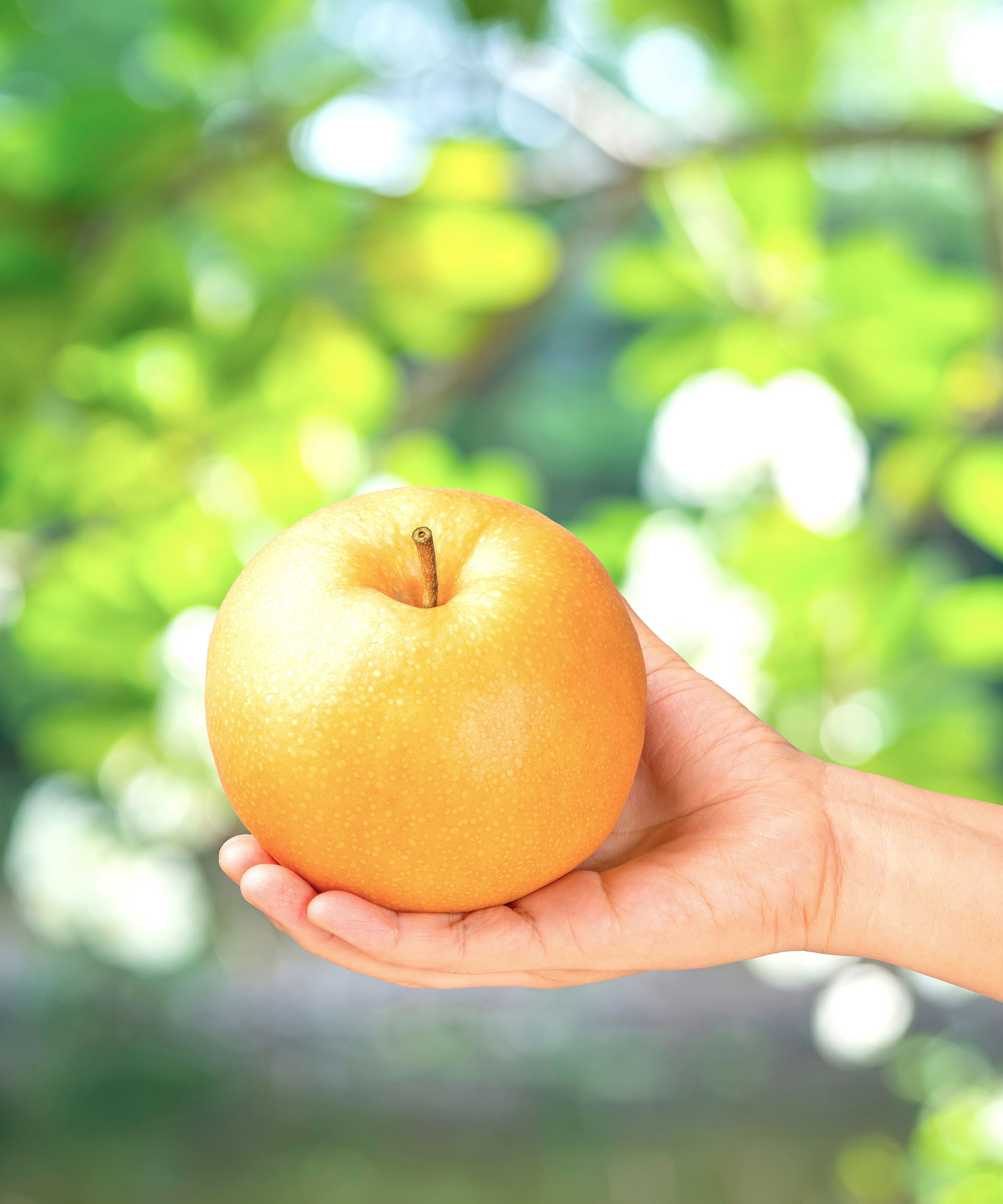
They look like big apples but nashi fruits are genuine full pears
Ideal conditions for growing Asian pears
Deciding where to grow Asian pears is easier when you consider their native climates. Combining warmth and good airflow is key to cultivating the most luscious and well-honed fruits. Nashi pears fare best when grown in full sunshine for at least half the day, and thrive in USDA zones 5-9.
‘Asian pears thrive in full sun, so select a location that receives at least six-eight hours of direct sunlight per day,’ says landscape designer Ward Dilmore, co-founder of Petrus. ‘This way, the tree can produce ample fruit in the growing season.’ As well as making nashi trees a priority in Japanese garden ideas, Asian pears do well in south-facing garden ideas and spots where you catch a lot of west-facing sun.
Ranging in size from 15-40ft tall, depending on variety, you need to give some thought to where your tree will establish, and ensure that any spot allows for both eventual height, and nearby shrubs and trees. As well as sunshine, adequate airflow is essential for healthy foliage, flowers and fruits. Planting temperatures in the region of 50-75ºF are most effective. You also need a fairly neutral pH for the best growing conditions. ‘Asian pears thrive best in soils with a pH of 6-7; says Fast Growing Trees’ plant expert Sydni D’Amico. ‘Test soil types before planting to ensure it is within this range.’ It’s also wise to ensure any planting site is well draining and moist. While established trees are drought-tolerant, young trees need good water access. If you aren’t sure, check soil types and adapt accordingly.
The breed you select will also have some bearing on how healthy and prolific your Asian pear fruits are. ‘Choose one that is well suited to your climate and preferences,’ says Ward. ‘Popular varieties include ‘Hosui’, ‘Shinko’ and ‘Shinseiki’, and there are many varieties which are disease-resistant,’ he adds. Other great varieties include early-fruiting dwarf ‘Chojuro’ and abundant ‘Nijisseiki.’ Grow from pot-based or bare-root plants sourced from garden centers and mail-order suppliers like those here:
- Buy Asian pear trees from Frog Hollow Farm
- Buy Asian pear trees from Fast Growing Trees
- Buy Asian pear trees from Roots To Fruits
- Buy Asian pear trees from Walmart

Sydni graduated from Texas State University with a degree in Geography Resources & Environmental Science and a minor in Horticulture. She has worked within various horticulture fields, including organic composting, organic gardening, fine-gardening, and landscape design. Her love for horticulture began at a young age, gaining experience from her father’s garden. She now shares her passions and skills at Fast Growing Trees.

Ward Dilmore is a landscape designer and founder of Petrus Landscape in the Bay Area of San Francisco. With an unconventional blend of horticulture expertise and international relations background, Ward brings innovation and sustainable creativity to his designs. His commitment to merging beauty with eco-conscious practices help to carve a path of bold, fresh perspectives in the world of landscaping.
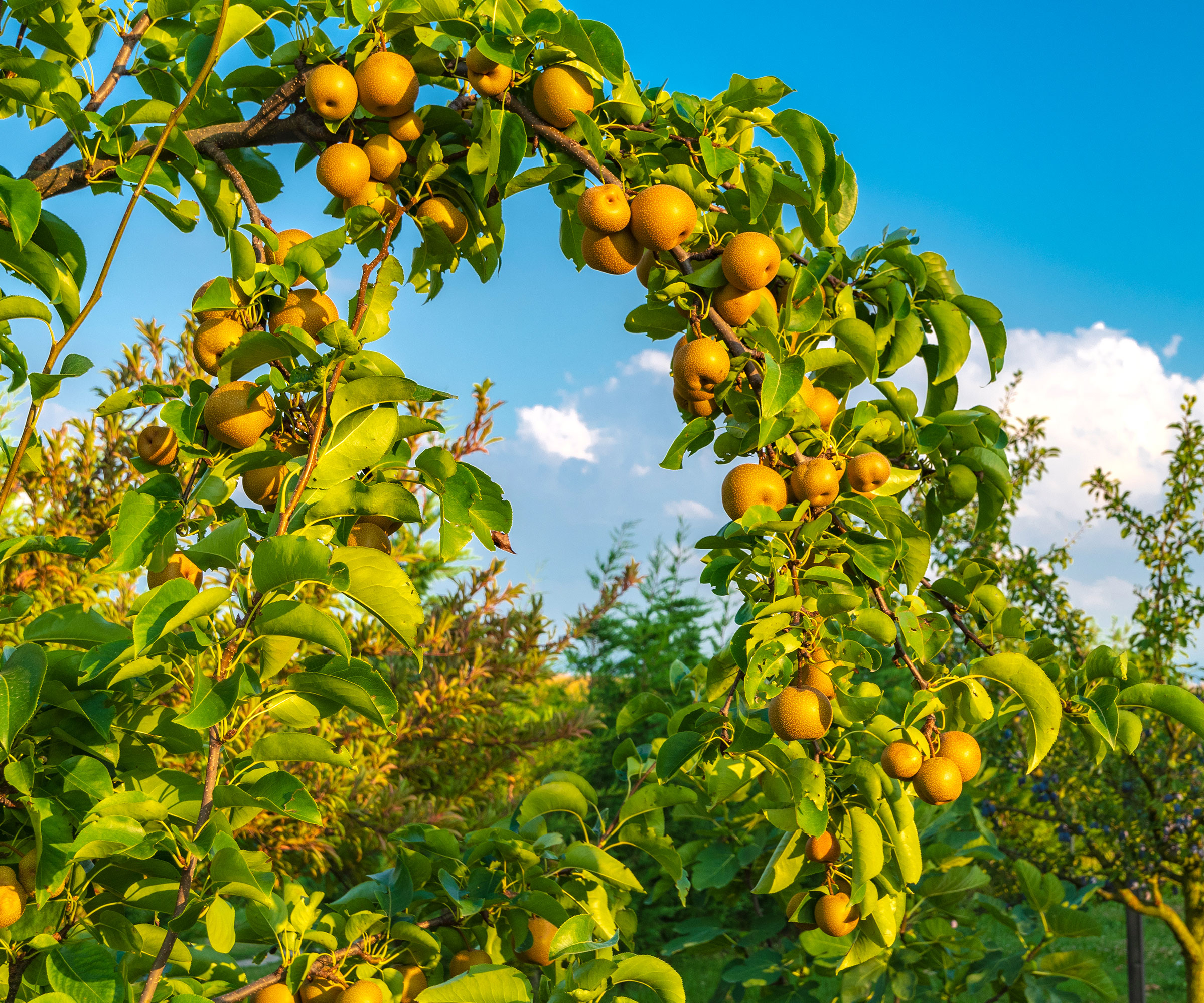
Asian pears need plenty of sunshine and good airflow around trees
When and how to grow Asian pears
Deciding when you grow Asian pears isn’t too tricky if you have given due consideration to native conditions. Avoiding any risk of frost, the best times to grow bare root and pot on container-based trees are in late fall and early spring. Once you know when to plant fruit trees, the critical points in the calendar are April (for flowering) and August (for fruiting).
One of the most critical aspects to planting, aside from temperature and soil base, is the question of pollination. ‘Some varieties are self-fertile,’ says Sydni D’Amico. Certain varieties like ‘Shinseiki’ are able to fruit in isolation. ‘However, you get better quality and higher yields of fruit when you plant two or more trees together,’ she notes.
Anyone who understands the benefits of planning a garden for pollinators will understand why this is important. In this case, you have a couple of options when growing Asian pears, says Homes & Gardens fruit expert Lucy Chamberlain. ‘Planting two or more nashi varieties in close proximity boosts yield’, says Lucy. ‘Alternatively, plant a single late-blooming nashi close to an early-flowering pear tree: the two will happily pollinate each other.’
Just check any combinations are compatible and will flower at the same time. Given the eventual size of full-grown Asian pear trees, Ward Dilmore recommends that you plant your nashi trees 15-20ft apart to allow for optimum air circulation and growth. ‘Giving your pears a chance to cross-pollinate will result in increased vigor,’ says Lucy.
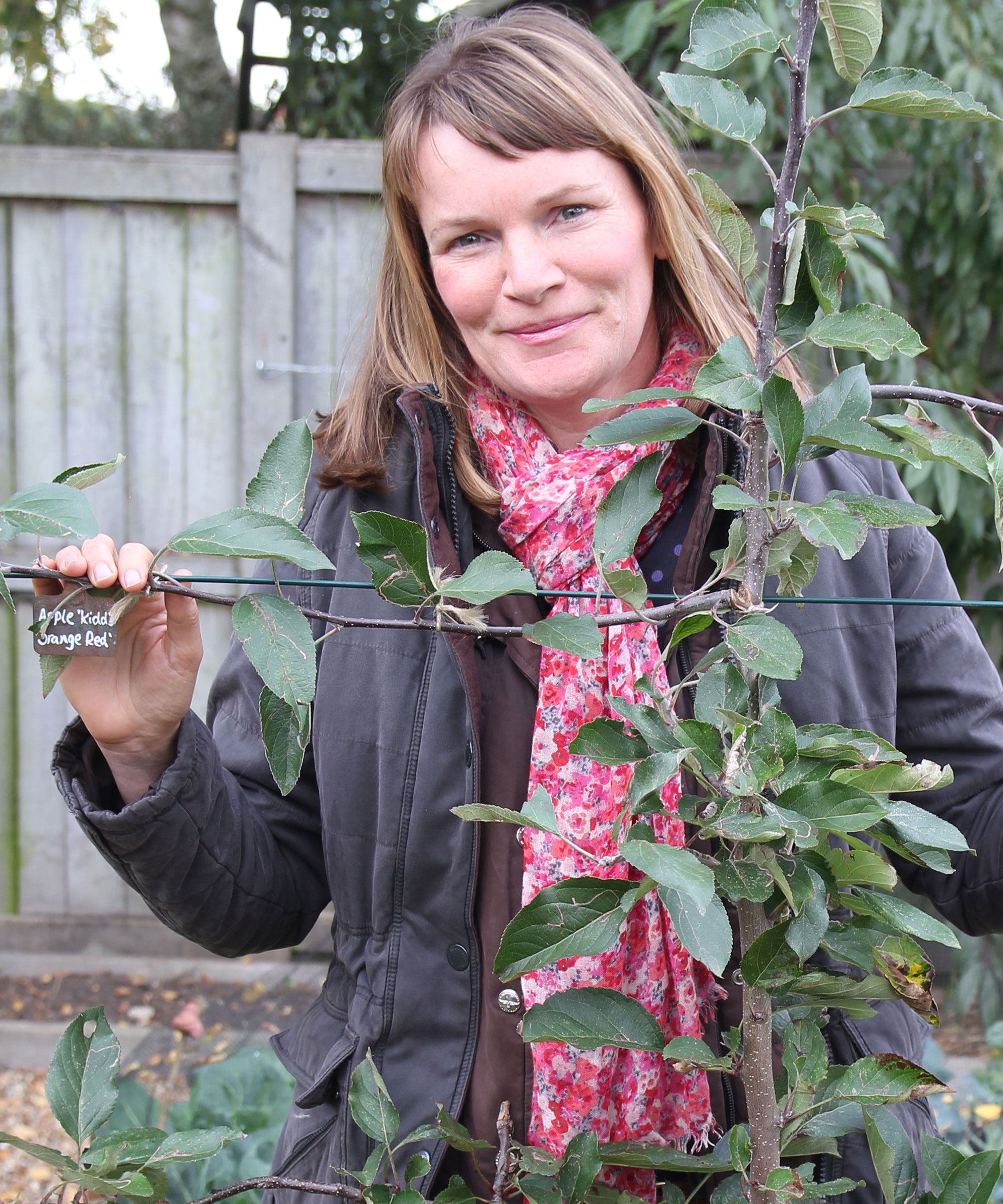
Lucy was a Horticultural Advisor at RHS Wisley and has been Head Gardener on a 100-acre estate in England for many years, but writes regularly for titles such as The Garden, Gardeners’ World, The Guardian and Amateur Gardening. She’s also the author of RHS Step by Step Veg Patch, which covers 50 types of fruit and veg.
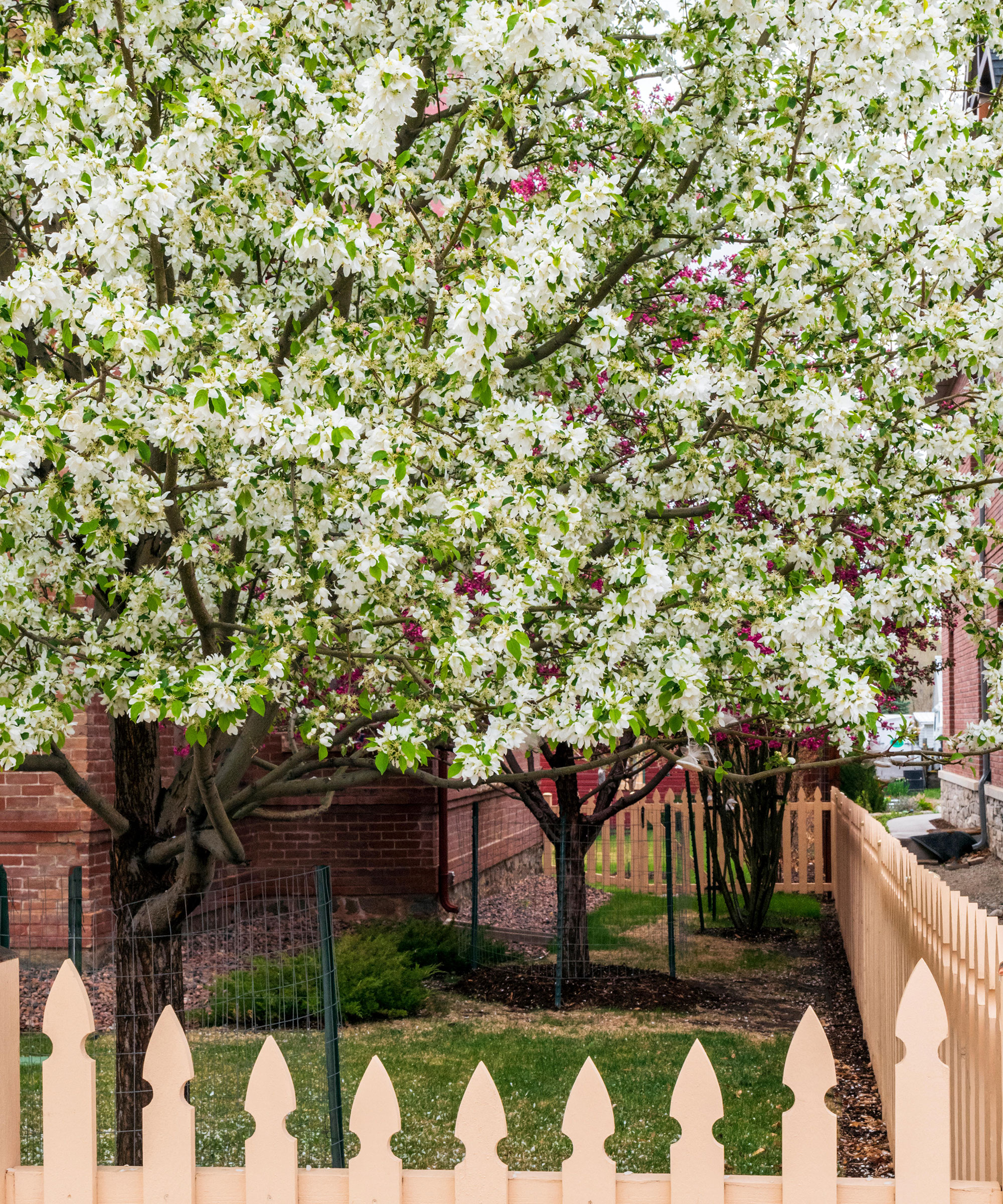
Though many varieties are self pollinating, asian pears are more prolific if you grow more than one
How to plant Asian pears
One of the first things to understand when learning how to grow Asian pears is the benefit of giving the ground a little boost prior to planting. It doesn’t have to be intensively nutrient-rich but, as Ward Dilmore points out, preparing garden soil helps to make sure the earth is workable and not waterlogged (hence why planting in the fall or spring is best).
Extricate any rocks or large debris, and ensure the site is free of weeds. If you are not happy with soil pH, adjust this a couple of months prior to growing Asian pears. You can also add a little organic matter to the earth in the form of aged loam or similar. Then follow these steps:
- Dig a planting hole as deep as the tree root ball and double the width. You want the tree to have plenty of opportunity for root development, but you also want the base and trunk of the tree kept free from soil.
- Loosen the roots and soak in a bucket or similar for a couple of hours before planting. Remove any broken or damaged roots. Place in the planting hole and check the base is level with the earth’s surface.
- Fill with a good blend of soil and aged compost. Moisten the earth before adding the top layer of soil. Continue to fill, and check the soil level is consistent. Tamp the ground to eradicate any air pockets.
- Give your newly planted tree a good watering. While established Asian pears are great for drought tolerant planting, you will need to keep the earth moist during the first weeks and months after planting.
- Add a mulching around the base of your tree, avoiding the trunk itself. It’s also wise to support young trees with a stake secured a few feet into the ground, taking care not to damage the root system.
- Repeat for every Asian pear tree you wish to plant. Make sure when planting that you give ample space (15-20ft) around each tree.
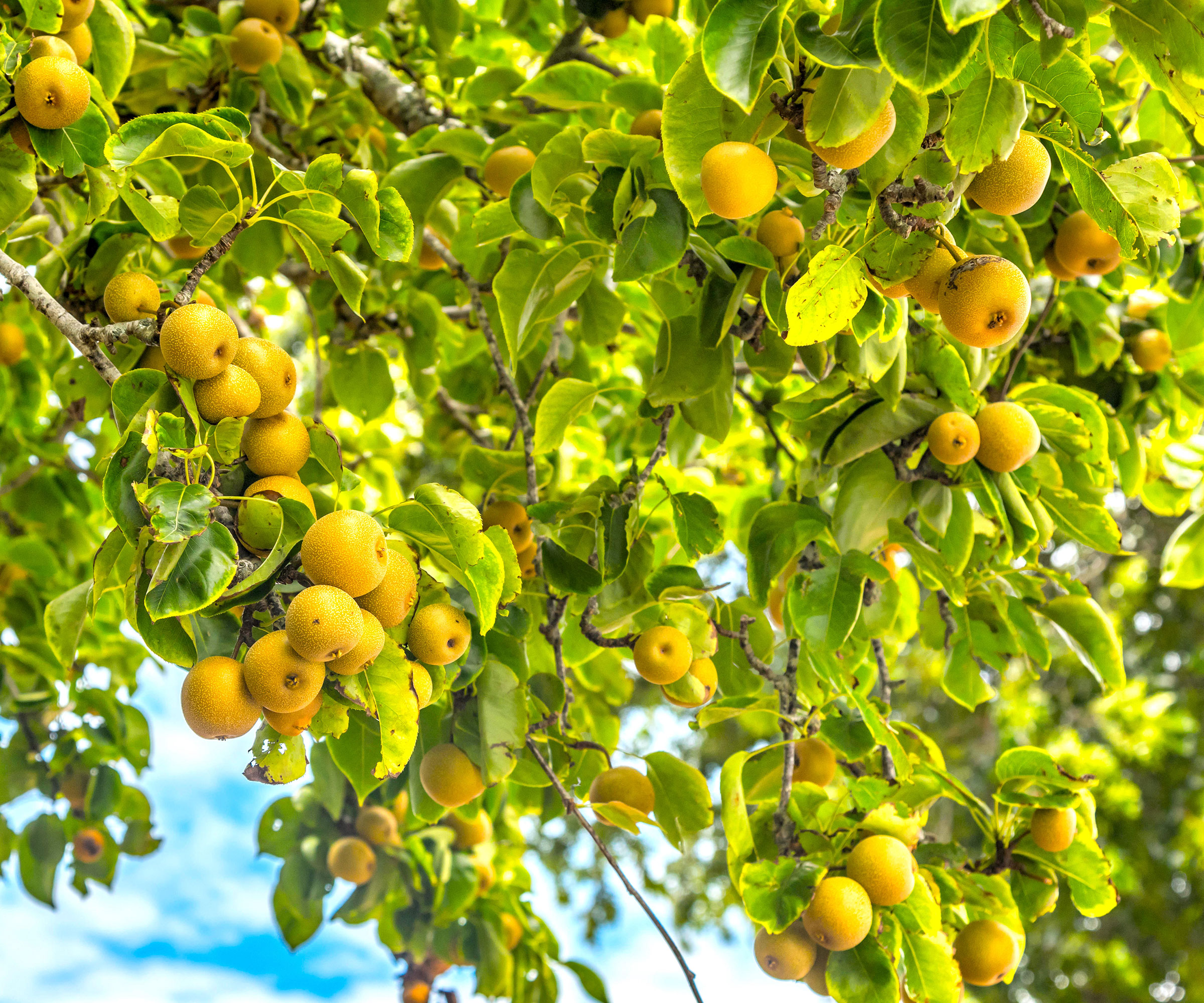
Planting in rich organic matter with strong early support give the healthiest branching and fullest foliage
Problems growing Asian pears and how to tackle them
You won’t have to worry about too many pests and diseases once you know how to grow Asian pears. There are only a few things to be wary of and to watch out for. As Ward Dilmore indicates, the main issues for nashi trees are aphids, pear slugs and fire blight.
‘Regularly inspect trees for signs of pests and diseases, so you can respond early and effectively,’ says Ward. Brownish areas on leaves are a sign of pear slugs – knowing some of the main slug control methods can keep this issue in check. A key sign of aphid infestation is a sticky honeydew on the foliage. You can get rid of aphids with biological controls and natural predators. One way to decimate numbers is by encouraging ladybugs and lacewings, which feed on aphids. You can also target aphids with short bursts of water on leaves or by spraying with mild soap or horticultural oil.
Fire blight tends to cause the most concern to Asian pears. As a bacterial disease, it announces its presence with blackened shoots and tips and a burned appearance to foliage. Prevention relies on making sure flowers aren’t vulnerable to prolonged bouts of wet or humid weather.
‘Choosing disease-resistant varieties (like Chojuo and Shinko) can also reduce the risk of infections,’ says Ward. Left untreated, fire blight is fatal to Asian pears. Caught early, you can contain its spread with immediate pruning below infected sites. ‘Neem oil and horticultural oil are great options for organic sprays and control pests and diseases effectively,’ says Ward.
Birds and wasps will also be drawn to ripening fruits. Try a protective netting or mesh to keep winged visitors from feasting on your nashi. Just make sure any net is well secured and taut, using a cage or frame, so birds don’t get trapped. A protective fence around your Asian pears can also help to keep hungry moose and deer at bay.
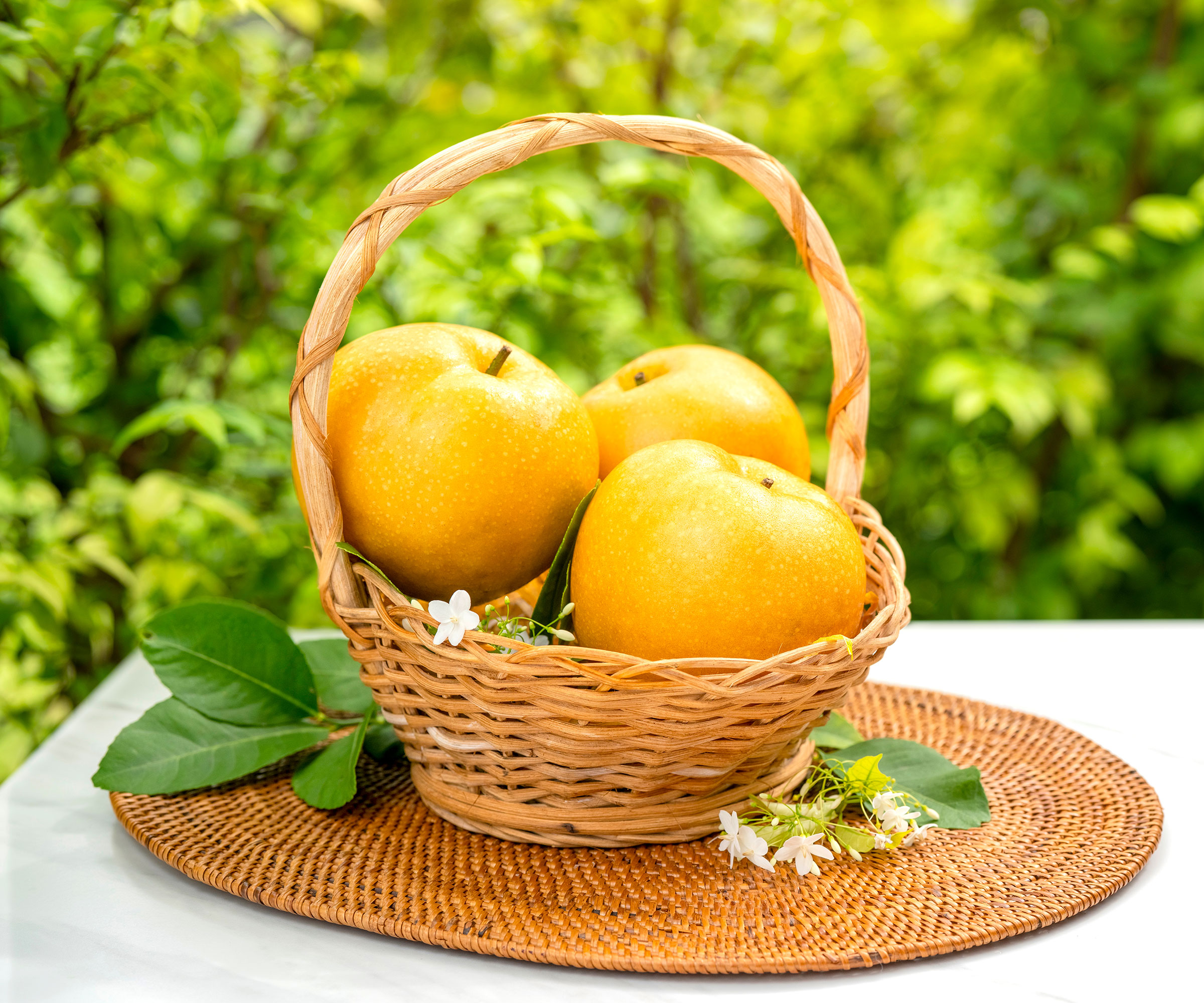
Harvest nashi when full, firm and heavy
FAQs
Can you grow Asian pears from seeds?
If you are a fan of collecting seeds from cropping shrubs and trees with a view to propagating future fruits, it is possible to grow Asian pears this way. However, any possible plants (and fruits) will not grow true, which means they won’t be exactly like their parent trees. It is generally more reliable (and quicker) to grow Asian pears from cuttings or grafting (as above).
That said, seed-based growing can be done. Just remember to refrigerate seeds for a few weeks first to nudge along the stratification process. Sow in pots with a light compost and sand mix. Young pear plants will likely take four or five years before they start to fruit.
If you have missed your planting window for starting Asian pears in the ground, you can also develop younger trees as part of container gardening groupings. If you do want to know how to grow Asian pears this way, bear in mind the essentials. Find the deepest pot, choose a good-quality compost, make sure the pot has drainage holes, and keep well hydrated.
Select a smaller variety (like ‘Chojuro’ or ‘Shinseiki’). Prune to keep your potted Asian pear at the six-foot mark, and thin to ensure good airflow. And don’t grow Asian pears in containers for more than a few years. Eventually, they need ground-based growing for the strongest roots, vigorous foliage and most mouth-watering fruits.
Sign up to the Homes & Gardens newsletter
Design expertise in your inbox – from inspiring decorating ideas and beautiful celebrity homes to practical gardening advice and shopping round-ups.

As assistant editor of Amateur Gardening magazine, Janey's gardening passion was fostered from an early age, when her amazing mum had her deadheading hydrangeas, mulching roses, and propagating strawberry plants from runners for school open days. She's also taken part in lots of conservation and rewilding projects for the RHS and TCV as a way of exploring her horticultural horizons.
-
 7 native perennials to plant in April – for glorious flowering displays to attract bees, butterflies, and hummingbirds
7 native perennials to plant in April – for glorious flowering displays to attract bees, butterflies, and hummingbirdsDiscover some of the best perennials to plant in April to make your garden a hotspot for wildlife
By Drew Swainston Published
-
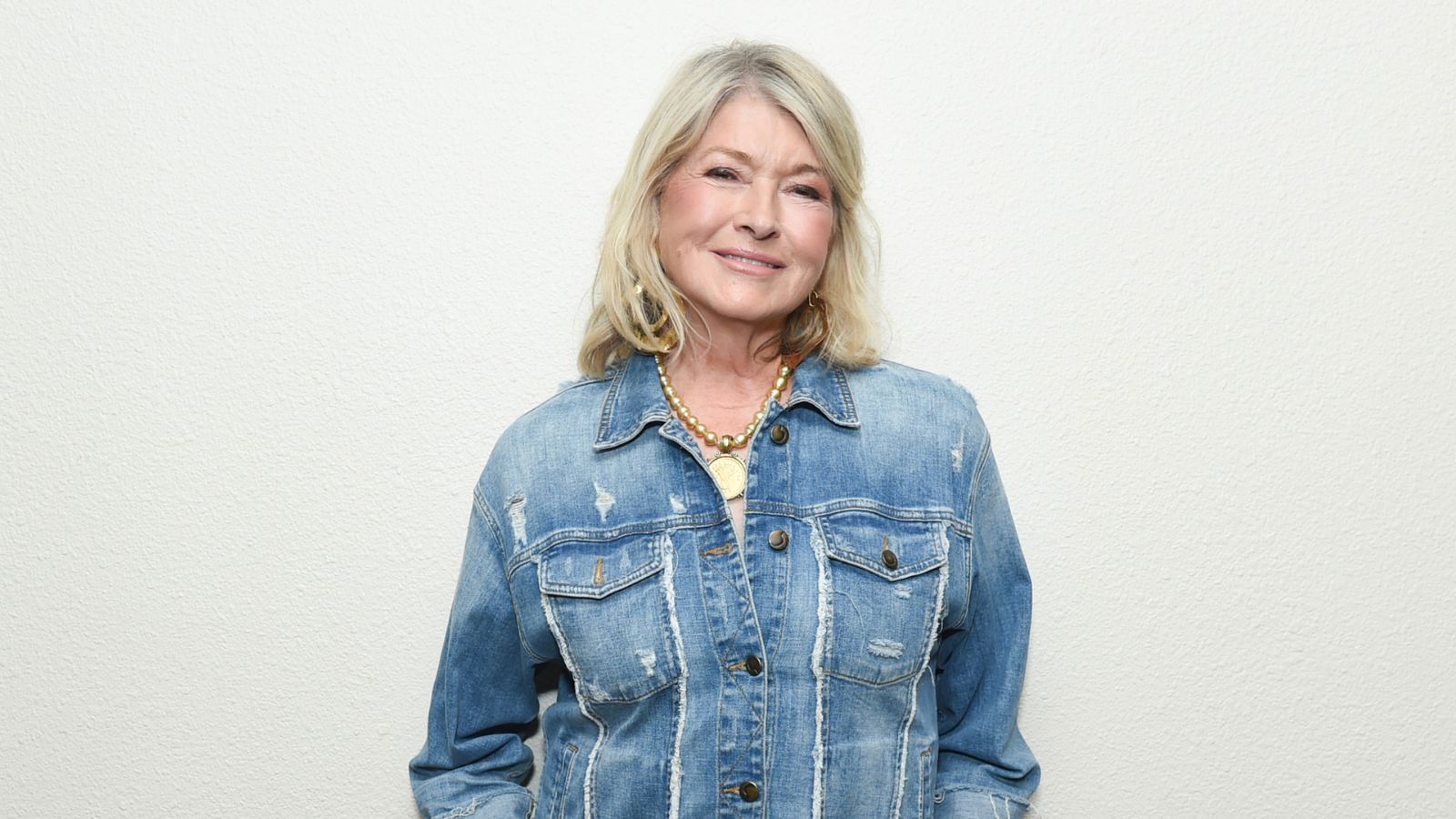 Martha Stewart's smart laundry room shelving makes exceptional use of every inch of wall space – it will turn your smallest area into an ultra-functional space
Martha Stewart's smart laundry room shelving makes exceptional use of every inch of wall space – it will turn your smallest area into an ultra-functional space'You can greatly expand the usability of your space by just installing some of these great shelving units': You can follow her technique for under $34
By Megan Slack Published